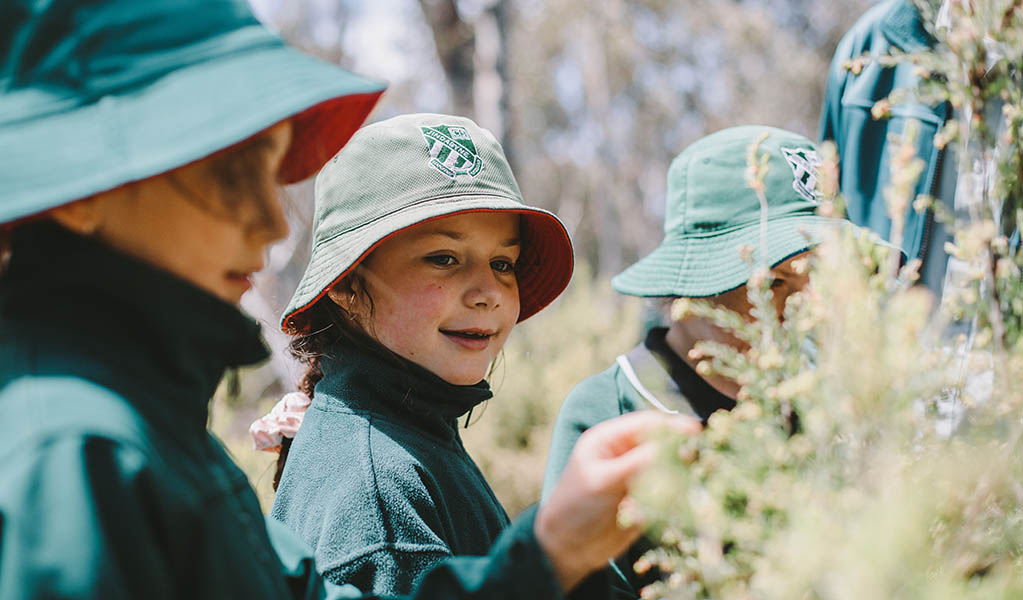School excursion
The Earth's environment
Stage 2 (Years 3-4), Geography, Hunter Wetlands National Park
Overview
Did you know that over 10 per cent of NSW is a national park? That’s over 7 million hectares. This Stage 2 (Years 3-4) Geography excursion is delivered Hunter Wetlands National Park.
Read more about The Earth's environment
Students will learn about the critical role NSW National Parks plays in conserving our unique native plants, animals and rich cultural heritage.
They’ll explore the significance of the environment at Hunter Wetlands National Park, a Ramsar-listed wetland, and the important interrelationships between humans and nature. They will learn about the history and culture of the Aboriginal people and their relationship with this country.
Students will learn about the critical role national parks play in preserving our unique native plants, animals and rich cultural heritage. With their guide, they'll explore this place that's home to over 100 types of birds and 45 species of international migratory birds.
For program outline, safety and practical information about this excursion, see info for teachers
| Stage | Stage 2 (Years 3-4) |
|---|---|
| Learning area | Geography |
| Student outcomes |
GE2-1. Examines features and characteristics of places and environments GE2-2. Describes the ways people, places and environments interact GE2-3. Examines differing perceptions about the management of places and environments GE2-4. Acquires and communicates geographical information using geographical tools for inquiry |
| Objectives |
Students will:
|
Excursion details
- When
Weekdays all year.
- Availability
- Guided. Available on request. Subject to staff availability.
- Duration
- 4hrs
- Grading
- Medium. Guided activities in a suburban national park, on formed and uneven bushwalking tracks, and on a grassed picnic area.
- Price
-
$380 per group for 4 hours (includes GST). Shorter tours available. Maximum 30 students per group. For groups over 30 conditions apply.
- Accessibility
- Hard
- Meeting point
- Riverside Park in Hunter Wetlands National Park
- Equipment
provided - Yes. All equipment is provided.
- Booking
- If you would like to organise a NPWS school excursion please get in touch with local staff or use the 'Enquire' link for the online form.
Local alerts
For the latest updates on fires, closures and other alerts in this area, see https://www.nationalparks.nsw.gov.au/education/stage-2-geography-earths-environment-hunter-wetlands-national-park/local-alerts
Operated by
- School excursion inquiries - Newcastle Hunter
- 02 4927 3267
- discovery.newcastlehunter@environment.nsw.gov.au
- Hunter Wetland Centre, Sandgate Road, Shortland NSW
Park info
- in Hunter Wetlands National Park in the North Coast region
Hunter Wetlands National Park is always open but may have to close at times due to poor weather or fire danger.
Info for teachers
All the practical information you need to know about The Earth's environment.
Program outline
- Welcome, introductions, safety briefing and acknowledgement of Country – 15min
- Bushwalk to Scott’s Point – 40min
- Bushwalk to Riverside Park – 30min
- Morning tea – 15min
- Bushwalk investigating rehabilitation of the island – 30min
- Explore the diversity of life in the lagoons and along the mangrove boardwalk – 40min
- Lunch – 40min
- Role play looking at different jobs in NSW National Parks – 20min
- Conclusion and farewell – 10min
Getting there and parking
Get driving directions
Riverside Park is in the Ash Island precinct of Hunter Wetlands National Park. To get there from Newcastle:
- Follow the Pacific Highway north towards Hexham
- Turn right onto Ash Island Bridge
- Follow the signs to Riverside Park
What to bring
Everyone needs to wear a hat and sunscreen, bring wet weather gear, and lunch which should be low waste with a refillable water bottle. Drinking water is available at the schoolhouse. Students should bring gear in a backpack or similar (not plastic bags).
Maps and downloads
Risk assessment and risk benefits
Our rangers and guides have the technical skill and experience to assess the risks and the benefits of a variety of activities delivered as part of our learning programs.
We believe in including opportunities that allow students to learn and experience for themselves through exploration in the natural environment.
Please make your own risk assessment based on the information provided. Detailed potential risks and controls are provided for the site to assist teachers in risk management planning. Teachers and carers should be aware of, and consider the needs, abilities and medical conditions of students when visiting this site. The supervision of students remains the responsibility of the teacher. The school must ensure an adequate number of adult supervisors are present.
Accessibility
Disability access level - hard
Please let us know in advance if you are bringing someone with special needs so that we can plan accordingly

